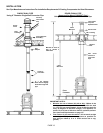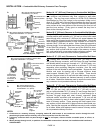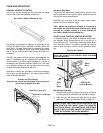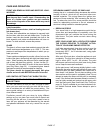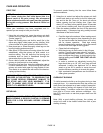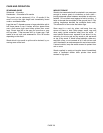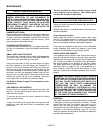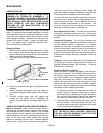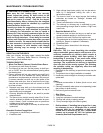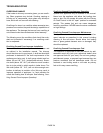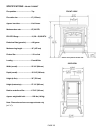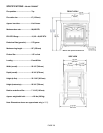
CARE AND OPERATION
PAGE 19
BURN RECOMMENDED FUEL
This appliance is designed for use with natural well-
seasoned wood. Do not burn particleboard scraps or
pressed logs because they can produce conditions which
will deteriorate metal. Green or uncured wood does not
work well as fuel, and can cause increased creosote
buildups. The value of green wood as a source of heat is
limited. Do not overload or use kindling wood or mill ends
as primary fuel as this may cause overfiring. Overfiring is
a condition where excessive temperatures are reached,
beyond the design capabilities of the stove. The damage
that occurs from overfiring is not covered under the stove
warranty.
What is the best wood for the fire?
Some woods are easier to light than others (i.e. horn-
beam, beech, & oak do not light easily whereas aspen,
birch and lime light easily but they do not last as long).
Then come the softwoods and conifers. Regardless if
you are burning a softer or harder wood, what is most
important is that it is well-seasoned dry wood. Damp
wood has far less heating power, this lowers the com-
bustion temperature of the fire therefore, the output.
Green wood is difficult to light, it burns badly and gives
off smoke and causes the formation of deposits (tarring
and soot staining) in the chimney flue and on the door
glass.
What is tarring and soot staining in the chimney?
When the smoke arrives in the chimney at low tempera-
ture, part of the water vapor which they convey con-
denses. The heaviest constituents are deposited on the
inside of the flue (this is TARRING). The mixture oxidizes
in the air and forms brownish patches (this is SOOT
STAINING). Four essential points for avoiding these
drawbacks, use dry wood, use a stove designed for
wood, connect it to a chimney with thick walls and of suit-
able cross-section (size and height), and ensure the con-
necting pipes are as short as possible (horizontal pipes
should be no more than 6" / 150mm).
Flue Gas Temperature
It is recommended to thoroughly heat the flue system
during start-up, before adjusting the burn rate to a me-
dium or low setting (see How To Start And Maintain A
Fire, Page 16). To ensure that the flue system is thor-
oughly heated, adjust the primary air to a medium/high
position for approximately 20-25 minutes after the start-
up air is closed before adjusting to a lower setting. This
helps to establish the draft and it reduces creosote de-
posits on the internal surfaces of the stove, glass and
chimney.
Hints:
Creosote condenses in a cold chimney, not a warm
one. Avoid a smoldering fire for more than a twelve-
hour period and your chimney will never get cold.
Burn a hot fire for a short period once or twice a day
(and after reloading), and then adjust the primary air
draft module to a medium or low position.
When loading wood, add one or two logs at a time,
depending on size. Loading the appliance full of
damp wood on a low fire is certain to cause poor
combustion efficiency resulting in creosote and dirty
glass.
If the wood is not quite as dry as it should be, to as-
sist for a short period, smokeless coal can be added
with the wood to raise the combustion temperature.
Have the chimney cleaned and inspected by a pro-
fessional chimney sweep once a year.
WARNING: BURNING IMPROPER FUEL (I.E. CHAR-
COAL) CAN RESULT IN CARBON MONOXIDE POI-
SONING WHICH MAY LEAD TO DEATH!
CARBON MONOXIDE POISONING – EARLY SIGNS
OF CARBON MONOXIDE POISONING RESEMBLE
THE FLU WITH HEADACHES, DIZZINESS, OR NAU-
SEA. IF YOU HAVE THESE SIGNS, GET FRESH AIR
AT ONCE! HAVE THE HEATER INSPECTED BY A
QUALIFIED SERVICE TECHNICIAN. SOME PEOPLE
ARE MORE AFFECTED BY CARBON MONOXIDE
THAN OTHERS. THESE INCLUDE PREGNANT
WOMEN, PEOPLE WITH HEART OR LUNG DISEASE
OR ANEMIA, THOSE UNDER THE INFLUENCE OF
ALCOHOL, AND THOSE AT HIGH ALTITUDES.
WHY SEASON WOOD?
The key to the success of a good fire that produces heat
from a woodstove is the wood. It needs to be well-
seasoned natural wood.
What does “Well-Seasoned” mean?
When a tree is cut down, the wood is green, full of sap and
moisture. This moisture content can exceed 80%, which
must be reduced to less than 20%. Wood properly sea-
soned is then capable of generating the heat the stove was
designed to provide.
Green wood does not burn easily. Attempting to burn
green wood often results in a lot of smoke and very little
fire. Time is the most important factor in seasoning wood.
Ideally the moisture content should be reduced to 11-20%,
although very few of us will be able to check that figure.
There are several steps that should be taken to ensure that
you come close to these figures.





